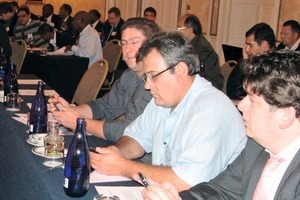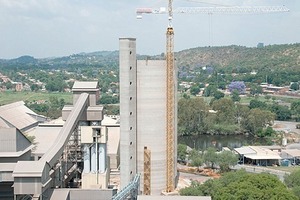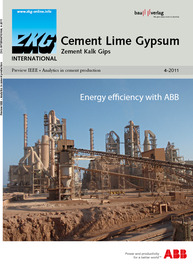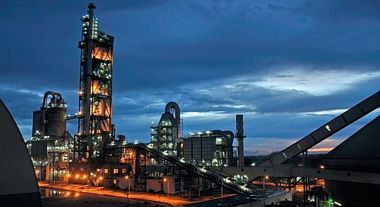Development of the cement industry in Africa
Second Environmental Cement Africa Conference, Nairobi/Kenya (11.-12.05.2011)
Following the successful inauguration of the conference in Cape Town last year, the 2nd Environmental Cement Africa Conference 2011 will this year take place in Nairobi/Kenya. High-profile representatives from the cement industry, government, environmental institutions, and the finance sector will gather during the 11th and 12th of May at the Crowne Plaza Hotel to discuss environmental trends and initiatives, to share information and debate about good practice for Africa’s cement industry to comply with international emission targets.
“This year we are trying to give the conference a more strategic direction”, said Demsas Faloppa, CEO of Prescon Ltd, the event’s founder and organiser. “The debate will take place within the policy framework of international regulations and treaties and focus on the way forward for Africa’s cement industry. In practical terms, this also means to look at new technologies and approaches that are energy-sufficient and at the same time cost saving.”
Despite continuing global economic challenges, Africa’s cement sector, which contributes substantially to a country’s carbon emission total and its local air pollution, has seen a healthy growth in most regions. “The ongoing development and construction boom in many parts of Africa may account for the steady demand for cement in Africa and it is therefore important that environmental strategies and regulations are incorporated into Africa’s fast growing cement industry right from the start”, said Mr Faloppa. “Our conference is the only event on the continent that focuses exclusively on this through the fostering of long-term stakeholder debate and partnerships.”
The business situation seems favourable for an environmental cement conference. In a recent cement sector research report, Kestrel Capital noted that cement demand in Kenya grew at a compound annual growth rate of 12.9 % between 2003 and 2008. Uganda and Tanzania have also experienced this increased demand, as the East African region as a whole has experienced growth, the result of which has seen many of the region’s cement companies looking to invest in increased capacity.
However, not only the Eastern African region is witnessing a substantial growth and exciting developments in the cement industry. In West Africa Angola’s National Director of Buildings and Construction, Manuel Victor, declared just last summer that at least six new cement plants will be built in the country in the next three years and Nigeria’s largest cement producer, Dangote, is investing in new plants all over the continent.
In Southern Africa, Namibia has just celebrated the official opening of the Ohorongo Cement plant, the newest in Africa, which was co-financed by the Development Bank of Southern Africa (DBSA) and the European Investment Bank (EIB), and in South Africa a newly established environmental watchdog has started its work with the inspection of the country’s affluent cement sector.
Surendra Bhatia, deputy managing director of Kenya’s Athi River Mining cement company said that new entrants are making major progress due to use of new technologies. He said newer mills have lower maintenance costs while they enjoy higher energy efficiency which helps them cut their production costs and compete favourably. “New technology can save as much as a quarter on energy costs which is very significant in cement production,” said Mr Bhatia. Energy costs account for about one fifth of the production costs of cement while clinker- a mineral input in cement manufacture accounts for up to half of the costs.
Kaushit Pandit, the director of sales at Mombasa Cement, said his firm has been able to pass on savings on energy, clinker and distribution to the end consumer in the form of cheaper products. “Competitive price to our customers is the only reason we have been able to grow so fast,” said Mr Pandit, explained that his company has more than 15 % of the market share.
Demsas Faloppa estimated the situation of the African cement industry as follows: “....the challenge for cement manufacturers is the shift towards technologies that decrease for example the use of water, which is a limited resource in many African countries. Furthermore, energy use in the cement industry poses a significant immediate challenge, but is also an opportunity. A reduction in the reliance on fossil fuels for electrical and thermal energy will increasingly be the difference between successful and unsuccessful players in the market. With soaring costs, companies will increase their focus on the development of renewable- and alternative energy projects, such as electricity generation from waste heat and alternative fuels.”
“Many cement companies have shown a keen interest in attending our 2nd Environmental Cement Africa Conference in Nairobi in May - including European headquarters such as Lafarge and Heidelberg Cement who run cement plants and businesses in Africa”, Mr Faloppa explained. “I think the fact that the conference programme concentrates on policy issues and initiatives and the strategic approach that we take by promoting environmental solutions not as an obligation, but as an actual key for achieving economic and competitive advantage in the medium and long-term is very attractive to our delegates.”
African and international delegates at the 2nd Environmental Cement Africa Conference, which is co-sponsored by Bamburi Cement Kenya, and which also features an exhibition, prestigious gala dinner and a cement plant visit, will have a rare opportunity to network and discuss a whole range of environmental issues in the context of both environmental protection and strategic business growth within Africa’s cement industry. For more information about the conference please contact
Ms Donna Campbell (donna@prescon-int.com). For sponsorship interest please contact Tom Harrison (tom.harrison@prescon-int.com).
www.prescon-int.com








